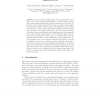Free Online Productivity Tools
i2Speak
i2Symbol
i2OCR
iTex2Img
iWeb2Print
iWeb2Shot
i2Type
iPdf2Split
iPdf2Merge
i2Bopomofo
i2Arabic
i2Style
i2Image
i2PDF
iLatex2Rtf
Sci2ools
MICCAI
2003
Springer
2003
Springer
Robust Estimation for Brain Tumor Segmentation
Given models for healthy brains, tumor segmentation can be seen as a process of detecting abnormalities or outliers that are present with certain image intensity and geometric properties. In this paper, we propose a method that segments brain tumor and edema in two stages. We first detect intensity outliers using robust estimation of the location and dispersion of the normal brain tissue intensity clusters. We then apply geometric and spatial constraints to the detected abnormalities or outliers. Previously published tumor segmentation methods generally rely on the intensity enhancement in the T1-weighted image that appear with the gadolinium contrast agent, on strictly uniform intensity patterns and most often on user initialization of the segmentation. To our knowledge, none of the methods integrated the detection of edema in addition to tumor as a combined approach, although knowledge of the extent of edema is critical for planning and treatment. Our method relies on the information...
Brain Tissue Intensity | Intensity Outliers | Medical Imaging | MICCAI 2003 | Tumor Segmentation Methods |
| Added | 15 Nov 2009 |
| Updated | 15 Nov 2009 |
| Type | Conference |
| Year | 2003 |
| Where | MICCAI |
| Authors | Marcel Prastawa, Elizabeth Bullitt, Sean Ho, Guido Gerig |
Comments (0)

